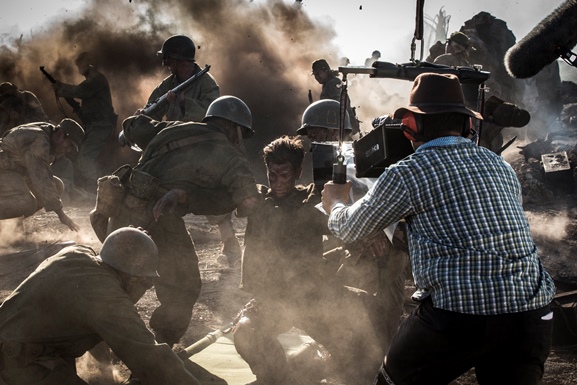Andrew Garfield being put through his paces on the set of 'Hacksaw Ridge'. (Photo credit: Mark Rogers).
Cutting Edge’s Head of Features Marcus Bolton, Visual Effects Supervisor Simon Maddison and Creative Director Finn Spencer chat to Harry Windsor about running post on Mel Gibson’s 'Hacksaw Ridge'.
The film, which is nominated for Best Picture at the Oscars, nabbed a BAFTA award on Sunday evening for Best Editing by John Gilbert.
What was CE's involvement in Hacksaw Ridge?
Bolton: We had a team of 25 people dedicated to the project to ensure we delivered to the deadline. Our VFX team worked on over 100 set extension shots, creating quite massive landscapes needed to be true to specific location in the United States. We were also lucky to be chosen to create the Titles and Credits design on the film.
What was the tendering process to get the gig?
Bolton: We were fortunate to have worked with Bill Mechanic on The Moon and the Sun and on 2:22, so we already had a rapport and trust on those projects.
Maddison: Even with the trust of Bill, it was also imperative to have the trust of the visual effects supervisor, Chris Godfrey. It was great to get the opportunity to work with him again. Chris’s attention to detail is unparalleled and it’s always amazing to share the ethos of such a skilled craftsman.
Spencer: The title and design language of the film was more a workshop than a tender. We understood we needed to bring a strong yet complementary design to the table, as it would become the trademark of the film.
What was it like working with Mel Gibson and producer Bill Mechanic?
Spencer: We had a great, open dialogue with Mel and Bill which gave us the opportunity to really understand the vision to then go back and present multiple options. It’s always good to have a commanding director who owns the brief and knows what they like when they see it, so it was a very rewarding process.
Maddison: Obviously for us, Mel was going to be instrumental in the vision of this project. Getting to work with one Australia’s most experienced and talented directors was a career highlight for me.
What were the chief challenges on this particular gig?
Maddison: Recreating a very specific part of the American landscape in Australia was always going to be challenging. But we feel we over-delivered on the attention to detail of the period and the location to make it historically correct and believable. Our sequences being a poignant and important part of the plot, we wanted to ensure viewers didn’t fall out of the moment and stayed focused on story.
Thoughts on the finished film?
Maddison: Even from the early stages of the edit, there was a lot of buzz about it being a really great film. But it’s often hard when working on sequences in isolation, to get a sense of what a film actually is until you see the finished product. When we sat down in that final screening the whole team was pretty blown away with what a great and well-told story it was – the performances were amazing and the action was incredible. It’s not until you see your shots as part of the larger finished project that you appreciate just how amazing a film it is. For Cutting Edge, to get the opportunity to help take the finished film to a whole new level was very humbling.
Bolton: The team at Cutting Edge is really proud to be part of such a landmark film. It’s not everyday you get to work on a film that gets a standing ovation at the Venice Film Festival and as Mel Gibson’s first film in 10 years, it was great to spur on the local community for production of shoot and post. Producing local projects worthy of the world stage is what we as a community get up in the morning to do. Continuing to further the pedigree of our creative director Finnegan Spencer’s multi-award winning title design work was another highlight.
* This interview has been edited and condensed.


